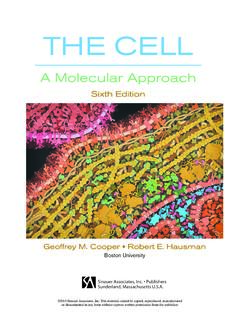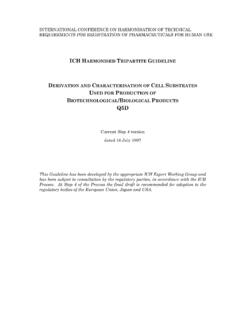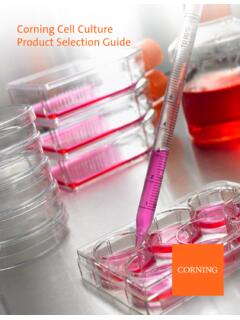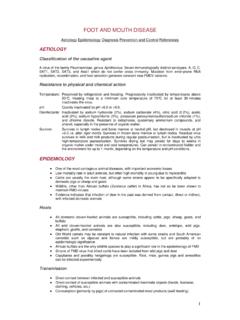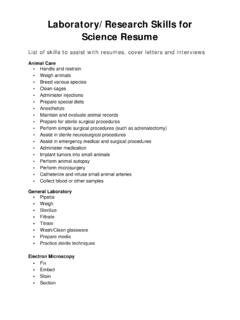Transcription of Stem Cell Basics - Introduction
1 - 1 - stem Cell Basics - Introduction For centuries, scientists have known that certain animals can regenerate missing parts of their bodies. Humans actually share this ability with animals like the starfish and the newt. Although we can't replace a missing leg or a finger, our bodies are constantly regenerating blood, skin, and other tissues. The identity of the powerful cells that allow us to regenerate some tissues was first revealed when experiments with bone marrow in the 1950s established the existence of stem cells in our bodies and led to the development of bone marrow transplantation, a therapy now widely used in medicine. This discovery raised hope in the medical potential of regeneration. For the first time in history, it became possible for physicians to regenerate a damaged tissue with a new supply of healthy cells by drawing on the unique ability of stem cells to create many of the body's specialized cell types.
2 Once they had recognized the medical potential of regeneration through the success of bone marrow transplants, scientists sought to identify similar cells within the embryo. Early studies of human development had demonstrated that the cells of the embryo were capable of producing every cell type in the human body. Scientists were able to extract embryonic stem cells from mice in the 1980s, but it wasn't until 1998 that a team of scientists from the University of Wisconsin-Madison became the first group to isolate human embryonic stem cells and keep them alive in the laboratory. The team knew that they had in fact isolated stem cells because the cells could remain unspecialized for long periods of time, yet maintained the ability to transform into a variety of specialized cell types, including nerve, gut, muscle, bone, and cartilage cells .
3 stem cell research is being pursued in the hope of achieving major medical breakthroughs. Scientists are striving to create therapies that rebuild or replace damaged cells with tissues grown from stem cells and offer hope to people suffering from cancer, diabetes, cardiovascular disease, spinal-cord injuries, and many other disorders. Both adult and embryonic stem cells may also provide a route for scientists to develop valuable new methods of drug discovery and testing. They are also powerful tools for doing the research that leads to a better understanding of the basic biology of the human body. By drawing on expert scientists, doctors, bioethicists, and others, the National Academies have examined the potential of stem cell technologies for medicine and provided a forum for discussing the ethical implications and moral dilemmas of stem cell research.
4 What is a stem Cell? Ultimately, every cell in the human body can be traced back to a fertilized egg that came into existence from the union of egg and sperm. But the body is made up of over 200 different types of cells , not just one. All of these cell types come from a pool of stem cells in the early embryo. During early development, as well as later in life, various types of stem cells give rise to the specialized or differentiated cells that carry out the specific functions of the body, such as skin, blood, muscle, and nerve cells . Over the past two decades, scientists have been gradually deciphering the processes by which unspecialized stem cells become the many specialized cell types in the body. stem cells can regenerate themselves or produce specialized cell types. This property makes stem cells appealing for scientists seeking to create medical treatments that replace lost or damaged cells .
5 - 2 - - 3 - Types of stem cells stem cells are found in all of us, from the early stages of human development to the end of life. All stem cells may prove useful for medical research, but each of the different types has both promise and limitations. Embryonic stem cells , which can be derived from a very early stage in human development, have the potential to produce all of the body's cell types. Adult stem cells , which are found in certain tissues in fully developed humans, from babies to adults, may be limited to producing only certain types of specialized cells . Recently, scientists have also identified stem cells in umbilical cord blood and the placenta that can give rise to the various types of blood cells . Embryonic stem cells A blastocyst (BLAST-oh-sist), is a pre-implantation embryo that develops 5 days after the fertilization of an egg by a sperm.
6 It contains all the material necessary for the development of a complete human being. The blastocyst is a mostly hollow sphere of cells that is smaller than the period at the end of this sentence. In its interior is the inner cell mass, which is composed of 30-34 cells that are referred to by scientists as pluripotent because they can differentiate into all of the cell types of the body. In comon usage, "embryo" can refer to all stages of development from fertilization until a somewhat ill-defined stage when it is called a fetus. Scientists use terms such as "morula" and "blastocyst" to refer to precise, specific stages of pre-implantation development. In order to be as precise as possible, this booklet uses the scientific terms when describing scientific concepts but uses the term "embryo" where more precision seemed likely to confuse rather than clarify.
7 In normal development, the blastocyst would implant in the wall of the uterus to become the embryo and continue developing into a mature organism. Its outer cells would begin to form the placenta and the inner cell mass would begin to differentiate into the progressively more specialized cell types of the body. When the blastocyst is used for stem cell research, scientists remove the inner cell mass and place these cells in a culture dish with a nutrient-rich liquid where they give rise to embryonic stem cells . Embryonic stem cells seem to be more flexible than stem cells found in adults, because they have the potential to produce every cell type in the human body. They are also generally easier to collect, purify and maintain in the laboratory than adult stem cells . Scientists can induce embryonic stem cells to replicate themselves in an undifferentiated state for very long periods of time before stimulating them to create specialized cells .
8 This means that just a few embryonic stem cells can build a large bank of stem cells to be used in experiments. However, such undifferentiated stem cells could not be used directly for tissue transplants because they can cause a type of tumor called a teratoma. To be used for therapies, embryonic stem cells would first need to be differentiated into specialized cell types. Some find embryonic stem cell research to be morally objectionable, because when scientists remove the inner cell mass, the blastocyst no longer has the potential to become a fully developed human being. - 4 - - 5 - Sources of Embryonic stem cells In Vitro Fertilization The largest potential source of blastocysts for stem cell research is from in vitro fertilization (IVF) clinics.
9 The process of IVF requires the retrieval of a woman's eggs via a surgical procedure after undergoing an intensive regimen of "fertility drugs," which stimulate her ovaries to produce multiple mature eggs. When IVF is used for reproductive purposes, doctors typically fertilize all of the donated eggs in order to maximize their chance of producing a viable blastocyst that can be implanted in the womb. Because not all the fertilized eggs are implanted, this has resulted in a large bank of "excess" blastocysts that are currently stored in freezers around the country. The blastocysts stored in IVF clinics could prove to be a major source of embryonic stem cells for use in medical research. However, because most of these blastocysts were created before the advent of stem cell research, most donors were not asked for their permission to use these left-over blastocysts for research.
10 The IVF technique could potentially also be used to produce blastocysts specifically for research purposes. This would facilitate the isolation of stem cells with specific genetic traits necessary for the study of particular diseases. For example, it may be possible to study the origins of an inherited disease like cystic fibrosis using stem cells made from egg and sperm donors who have this disease. The creation of stem cells specifically for research using IVF is, however, ethically problematic for some people because it involves intentionally creating a blastocyst that will never develop into a human being. Nuclear Transfer: The process called nuclear transfer offers another potential way to produce embryonic stem cells . In animals, nuclear transfer has been accomplished by inserting the nucleus of an already differentiated adult cell-for example, a skin cell-into a donated egg that has had its nucleus removed.










